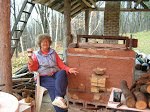
The end of the journey workshop at Center Street Clay is on Oct 22-24. Probably just three more gas firings as summer visitors will take up some time in August so I really do not have too much time left. Steven suggested that for the gallery show I have 3 to 4 large pieces either slab or thrown and then several smaller items - again thrown or handbuilt.

I think that I need to take more pictures from more angles for my handbuilt pots as from some angles the form is not at all attractive, but it is hard for Steven to comment on that as he has no way of seeing it - though Steven said that apart from a definite front and back there will always be one view that is not as good as some of the others.
It is strange how completely my views have changed on decorating pots. Pre-Steven I only decorated one side - after all you cannot see all sides at once. Now I find that I just have to do the decorating on the back as well, in fact I enjoy coming up with something different but still meaningful for the back.


After all the talk on Clayart about form over decoration, I wanted Steven's view. It all depends on who you are - whether you focus first on form or on decoration, but in the end you still need to look at form and both have to work together.
I definitely know that I focus on decoration as I don't think that I have ever made an undecorated pot.
We talked about the last two slab pots that I had made - one where I had taken all the best features from each of my previous pots and attempted to make "super" pot. I had also combined shellac resist on the applique work so that it would tie in with the resist work on the plates and casseroles. Somehow i just cannot make applique work look right on plates, bowls and cups. Steven says that it is a matter of scale mostly. The appliques ends up overwhelming the pot.
I have had trouble with cracking rims - where I had added clay strips to the top edges to give the pot a more substantial look. The last two times instead of cutting leatherhard strips and adding them, I rolled a clay coil and applied it quite wet to the leatherhard clay top and voila - no cracking but it is hard to make the rim thickness even!

Steven suggested another method, rolling down the rim with a small clay roller. He used to do that on slab platters that he used to make. This compresses the clay as well as thickens the rim so it no longer susceptible to cracking. You can also use the edge of the roller to make a line along the rim, or perhaps on the appliques.

This sounds like a very interesting technique that I will have to try as the vase with the two ladies I had left the rim unthickened and it definitely did not look very good. As Steven said the base of the vase is quite substantial with the flaring at the bottom, but the top just is very weak. Another suggestion was to use an extruded rim like I had done on one of the vases - and perhaps not even having it all around the top but just on some sections. That sounded like it had lot sod different possibilities - maybe to accentuate a wavy pot.
One of the other journey participants had been to Centre Street Clay to take one of Steven's electric glaze firing workshops. That is something that I want to take as well. Steven has been getting amazing results in electric. Maybe I can persuade the guild in Ottawa to invite him to give a workshop. Will have to work on that.

No comments:
Post a Comment